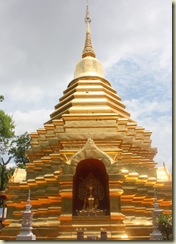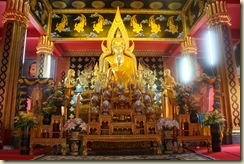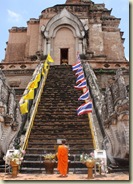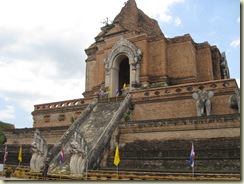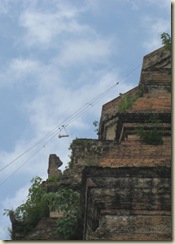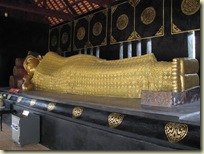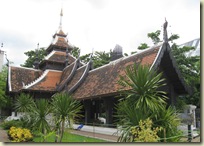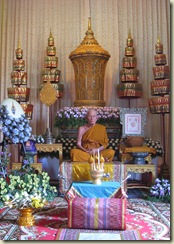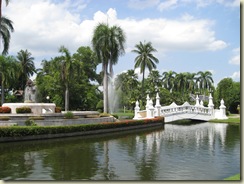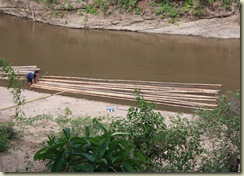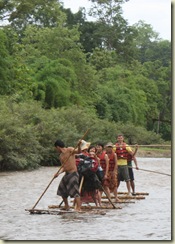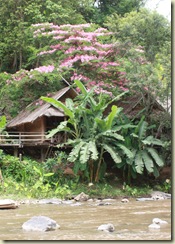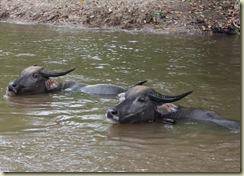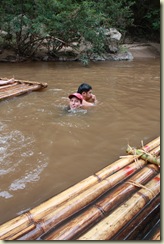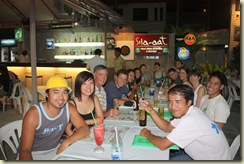Except for a few hours the previous day and a few hours tomorrow, today is my only day at Tokyo. I know that this is not nearly enough to make justice to this giant city, but for my first trip to Japan, I made the decision of going to the Japan Alps and Kyoto, rather than exploring Tokyo.
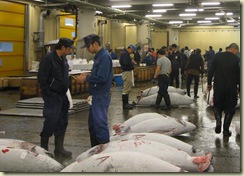 I started very early in the morning by going to the Tsukiji Fish market. It was pouring rain, but it didn't matter as the market is mostly enclosed in a huge hangar-like building. The market is huge with lots of activity going on. All this starts very early in the morning, in fact by the time I got there (5:45am), some was already wrapping up. The tuna auction area is now heavily restricted to tourist and only a small area is open to sightseers from 5:30am to 6:15am (no flash photography allowed). The auctions are fast paced and it's hard to figure out when it starts and ends. The huge tunas are frozen, laid down on the ground, and numbered. The prize for one of them can be up to a million yen ($10,000). After I was asked politely to leave at 6:15am, I went around the "intermediate wholesale area" where the wholesale fish (including the Tuna) are cut into smaller pieces to be sold to retailers.
I started very early in the morning by going to the Tsukiji Fish market. It was pouring rain, but it didn't matter as the market is mostly enclosed in a huge hangar-like building. The market is huge with lots of activity going on. All this starts very early in the morning, in fact by the time I got there (5:45am), some was already wrapping up. The tuna auction area is now heavily restricted to tourist and only a small area is open to sightseers from 5:30am to 6:15am (no flash photography allowed). The auctions are fast paced and it's hard to figure out when it starts and ends. The huge tunas are frozen, laid down on the ground, and numbered. The prize for one of them can be up to a million yen ($10,000). After I was asked politely to leave at 6:15am, I went around the "intermediate wholesale area" where the wholesale fish (including the Tuna) are cut into smaller pieces to be sold to retailers.
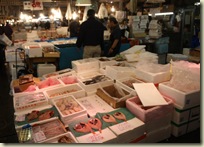 | 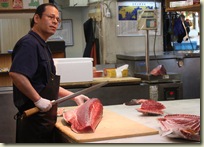 |
To be honest, the market is not very tourist friendly and many of the wholesalers see tourists as a nuisance. Flash photograph is a big no-no, and you'll politely asked to leave if you take your camera too close to an auction. In addition, this is a very busy place with special "barrel" vehicles going around at high speeds and people transporting very heavy loads. The floor is also quite wet and slippery. I'm surprised that my guidebook lists this place as the first place to visit in Japan. Except for the fact that being jet-lagged helps waking up at 5am to get there before the auction area is closed, it's a rough introduction to Tokyo. Still, I had lots of fun there, but I would be cautious about to whom I'd recommend going to the market.
From the market, my plan was to head to the Hama Rikyu garden where I was going to take a ferry boat to Asakusa. However, the gardens don't open until 9am and the rain was getting worse and worse. Eventually, I broke down and bought a 650 Yen umbrella in a mini-mart and went for a walk to make time before the gardens open. The walk took me to the Tsukiji shrine. An "empire" style building that opened just before the Second World War. From there, I explored some of the high rises near the gardens. These are quite impressive buildings with nice details and reflections on each other.
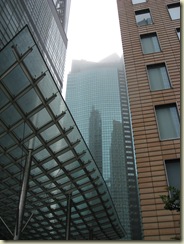 | 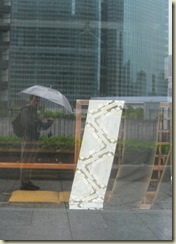 |
At 9am, I headed to the gardens. My guidebook considers them overrated and points out that the high rise buildings detract from the beauty of the garden. Maybe it was the rainy and foggy weather, but I actually found the contrast very nice. After the walk around the park, the rain was actually getting worse, so I decided to scrap the plan of going to Akasuka and instead I headed to the Tokyo National Museum for some indoor fun.
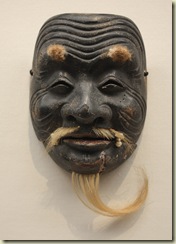
The Tokyo National Museum has an incredible collection of Japanese and Asian art. The collection rotates continuously, so I was told that every visit to the museum is different. During my visit, they had a special exhibit on Kabuki and they had impressive costumes and masks. They also have a good exhibit describing the progression of Japanese arts from pre-historic times to the XVIII century. The emphasis is on art, rather than history and IX and XX century art is, surprisingly, completely absent. A specially enjoyable exhibit was the Gallery of Horyuji Treasures, containing Buddhist pieces from the Horyuji temple in Nara.
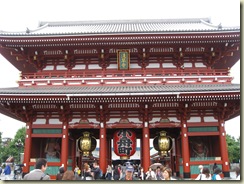 The weather was starting to look better, so I risked it by going to Akasuka. Of all Tokyo, this was the first place that feels as if you are in "Japan". Nakamise Dori, the street leading to the Sensoji Temple, was a lot of fun: people watching, yummy snacks, interesting souvenirs, plus people just living their normal life (there is a pre-school on that street). At the end of the street, you get to Sensoji Temple. Unfortunately, it's under renovation, so the whole building is enclosed in a metal structure and it was impossible to appreciate its arcghitecture. Inside the temple, I followed the Shinto ritual: first, wash myself using the smoke from incense, then walk to the shrine and throw some coins through the grid, bow twice, clap twice, bow again. After that, I went to get my fortune read using Buddhist sticks. For that, you take a cylinder with a small hole at the top that it's full of sticks and shake it until one comes out. Each stick has a number written in Chinese characters. Using that number, one locates a drawer, where the interpretation (in Japanese and English) is found. I got stick number 29 and looked in the drawer for the interpretation. I think I got as good as it gets (text is verbatim):
The weather was starting to look better, so I risked it by going to Akasuka. Of all Tokyo, this was the first place that feels as if you are in "Japan". Nakamise Dori, the street leading to the Sensoji Temple, was a lot of fun: people watching, yummy snacks, interesting souvenirs, plus people just living their normal life (there is a pre-school on that street). At the end of the street, you get to Sensoji Temple. Unfortunately, it's under renovation, so the whole building is enclosed in a metal structure and it was impossible to appreciate its arcghitecture. Inside the temple, I followed the Shinto ritual: first, wash myself using the smoke from incense, then walk to the shrine and throw some coins through the grid, bow twice, clap twice, bow again. After that, I went to get my fortune read using Buddhist sticks. For that, you take a cylinder with a small hole at the top that it's full of sticks and shake it until one comes out. Each stick has a number written in Chinese characters. Using that number, one locates a drawer, where the interpretation (in Japanese and English) is found. I got stick number 29 and looked in the drawer for the interpretation. I think I got as good as it gets (text is verbatim):
Everything you worry about and trouble some affairs are almost over. If you do your best, you will be successful in this society and become well-known. The wealth and treasures will be in your hand as you wish.
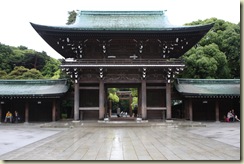
Now with my good fortune, but still in bad weather, I headed for the Meiji Jingu Shrine. This Shinto shrine opened in 1920 in honor of Emperor and Empress Meiji (122nd emperor of Japan). He took the initiative of opening the country to the world after a very long isolation period. He also introduce Western civilization and developed technology from overseas, while preserving the Japanese identity. So, he is considered the founder of modern Japan. The Shrine is in a forest built in honor of the Emperor which is a quite change from the busy streets of Tokyo.
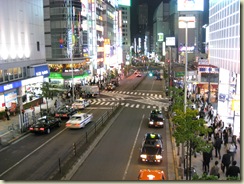
After the temple, a short subway ride took me back to my hotel and dinner. After that, I went to the train station to book my train tickets for the rest of the trip. I'm traveling using the JR pass which is an incredible deal for the kind of trip that I'm making. When making reservations, I found out that it's much better to write things down than trying to talk. It took some time, but I left the office with the three main reservations (to Takayama, to Kyoto, and back to the airport) that I needed.
From the reservation office, I decided to go and check out some of the stores in Shinjuku. I ended in a huge electronic store (Bic Camera). Something like Fry's but 8 stories high. The store has display models of everything, so it was a lot of fun to try computers, cell phones, cameras, etc. The latest trend in cell phones is flip smart phones with big screens, high resolution cameras, and turn by turn by turn directions. I ended buying a 8 Gb Class 6 HDSD card for just under $20 (I'll probably laugh at this price when I read it again a few years down the road). There was a big sign saying "Duty Free store", so I tried to ask the cashier about how to get the consumption tax back. I was presented with a nice leaflet that except for the title (Duty Free) was all in Japanese... Later I found on the web that you just need to present your passport and you get 5% consumption-tax discount on your purchase. However, one needs to buy at least 10,000 yens ($100), so my purchase didn't qualify anyway. After checking out some of the other stores (clothing is really expensive in Tokyo), my feet were hurting so it was time for me to go back to my hotel for the night. A very long and wet day in Tokyo was over.
Overall, my feelings about Tokyo changed throughout the day. It was expecting to find a cosmopolitan city like New York, London, or Paris, but instead I found a mega-town where people are not very diverse and, surprisingly, they are not used to foreigners. In addition, Tokyo is very expensive (specially with 94 yens = 1 dollar cash exchange rate) and the language barrier is high. Although everything in the subway is written in Japanese and Latin characters, the same is not true in the JR lines and on the streets. If you can't play pattern matching of Chinese characters, it's easy to get lost. But after I got over those initial difficulties, and I got better at navigating the city, the appeal of Tokyo increased. I'm looking forward to come back in the future with more time to explore the city further.
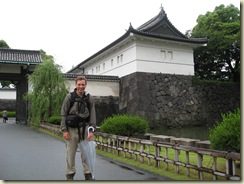 I started the day with a quick visit to the Imperial Palace. I didn't have much time so I just made it to the entrance of the East Gardens for a quick snapshot. The Gardens are just 4 long blocks from the Tokyo train station so it made a good stop before catching my train to Nagoya and Takayama. The weather was so rainy and foggy, that I could barely see the Tokyo Tower from the gardens.
I started the day with a quick visit to the Imperial Palace. I didn't have much time so I just made it to the entrance of the East Gardens for a quick snapshot. The Gardens are just 4 long blocks from the Tokyo train station so it made a good stop before catching my train to Nagoya and Takayama. The weather was so rainy and foggy, that I could barely see the Tokyo Tower from the gardens.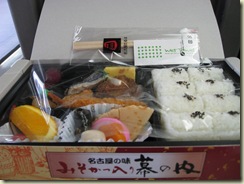 At the train station in Nagoya, I bought a lunch box. Plastic models of the content simplified choosing which box to pick, although I was wondering what the plastic rectangular yellow block was going to be (it was sweet potato). The train ride to Takayama is very scenic. It follows a river and go through a number of small mountain towns. The small Takayama train station has a very nice (English speaking) tourist information office just outside that provided me tips and bus time schedules.
At the train station in Nagoya, I bought a lunch box. Plastic models of the content simplified choosing which box to pick, although I was wondering what the plastic rectangular yellow block was going to be (it was sweet potato). The train ride to Takayama is very scenic. It follows a river and go through a number of small mountain towns. The small Takayama train station has a very nice (English speaking) tourist information office just outside that provided me tips and bus time schedules.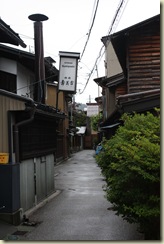 It was a 10 minutes walk from the train station to my Ryokan. The Sumiyoshi Ryokan, a traditional Japanese Inn, where I'm staying is located by the river in a small street of Takayama. It wasn't hard to find it thanks to the map that Japanese Guest Houses, the booking service that I used, provided. As I got there, I was warmly welcomed and shown to my room. The main concern of the host was that I understood the shoe policy: shoes off at the entrance, switch to slippers to walk around, slippers off on the tatami, slippers off and plastic slippers on in the bathroom. Very simple and civilized. Then, I was served a very strong green tea and a Japanese cookie. I was asked at what time I wanted dinner as well as breakfast the following day. I was offered the choice of Japanese or Continental breakfast (I chose Japanese).
It was a 10 minutes walk from the train station to my Ryokan. The Sumiyoshi Ryokan, a traditional Japanese Inn, where I'm staying is located by the river in a small street of Takayama. It wasn't hard to find it thanks to the map that Japanese Guest Houses, the booking service that I used, provided. As I got there, I was warmly welcomed and shown to my room. The main concern of the host was that I understood the shoe policy: shoes off at the entrance, switch to slippers to walk around, slippers off on the tatami, slippers off and plastic slippers on in the bathroom. Very simple and civilized. Then, I was served a very strong green tea and a Japanese cookie. I was asked at what time I wanted dinner as well as breakfast the following day. I was offered the choice of Japanese or Continental breakfast (I chose Japanese).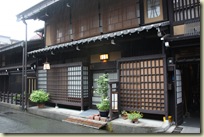
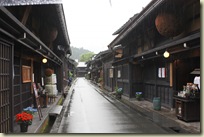
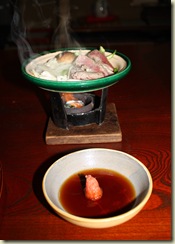 The main plate was Kobe beef cooked on my table with onions and sprouts with a tangy dipping sauce (a Takayama specialty). Then, tempura and rice. Followed by miso soup, pickles, and noodles. Finally, a very sweet fish and watermelon for dessert. All this was accompanied with sweet sake at first, and then a special green tea. I was pretty full at the end of all this... To be honest, I haven't eaten like this since the beginning of this trip.
The main plate was Kobe beef cooked on my table with onions and sprouts with a tangy dipping sauce (a Takayama specialty). Then, tempura and rice. Followed by miso soup, pickles, and noodles. Finally, a very sweet fish and watermelon for dessert. All this was accompanied with sweet sake at first, and then a special green tea. I was pretty full at the end of all this... To be honest, I haven't eaten like this since the beginning of this trip.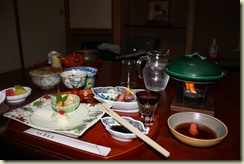





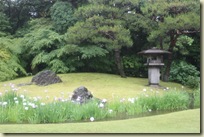
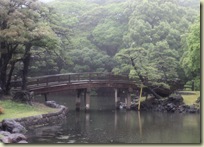
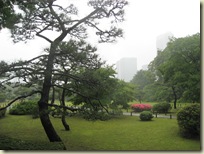
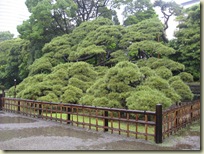





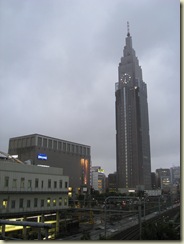
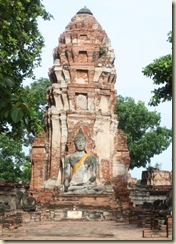
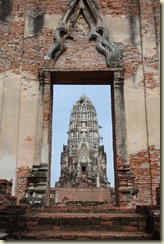
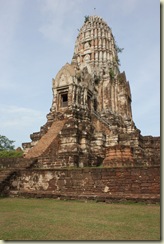
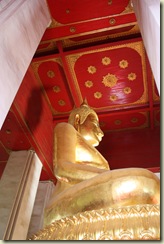
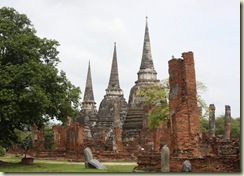
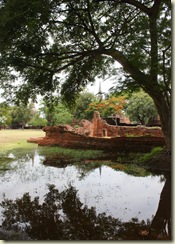
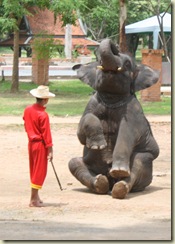
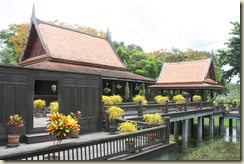
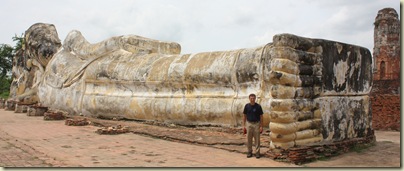

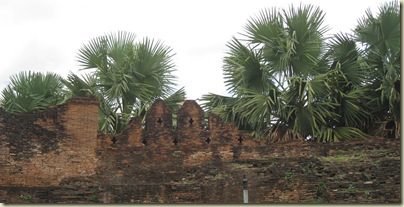
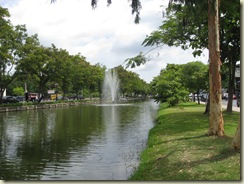 Chiang Mai was a walled city. A significant part of the walls is still present and the moat was converted in beautiful canals with fountains that are illuminated at night. Walking the old town is relatively easy as it follows a regular grid (with the occassional wat blocking the way) and if you get lost, you just need to walk until you hit one of the city walls or one of the named gates at the wall.
Chiang Mai was a walled city. A significant part of the walls is still present and the moat was converted in beautiful canals with fountains that are illuminated at night. Walking the old town is relatively easy as it follows a regular grid (with the occassional wat blocking the way) and if you get lost, you just need to walk until you hit one of the city walls or one of the named gates at the wall.
